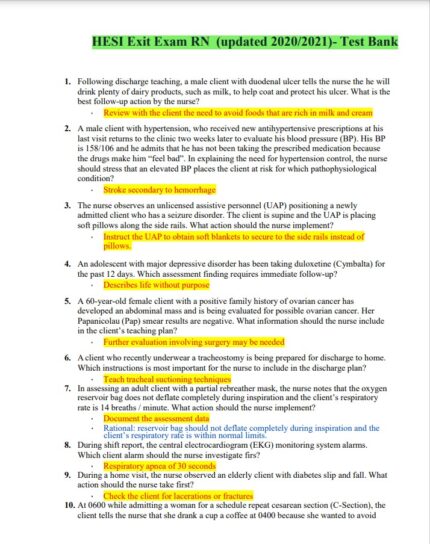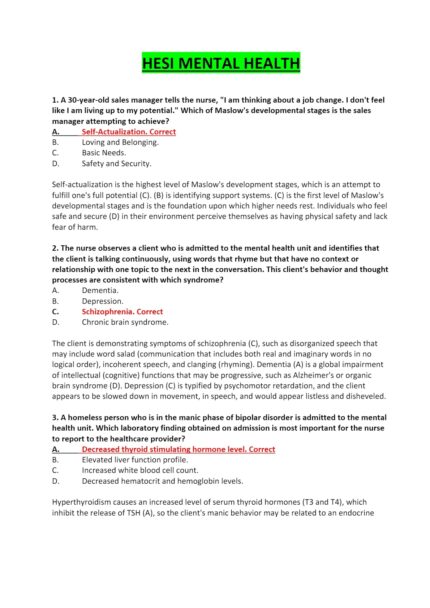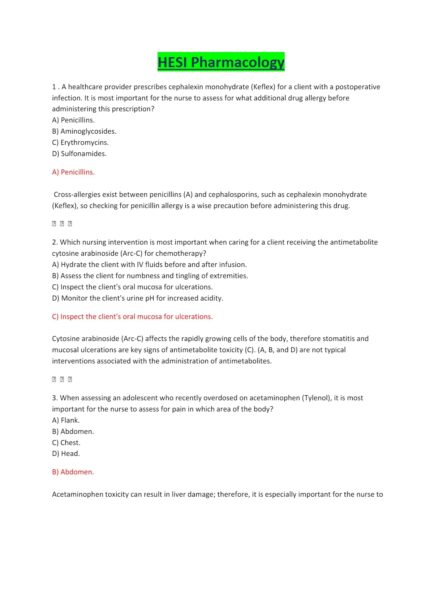EXIT HESI 2022 EXAM ANSWERED 100% GRADED A
An older client’s daughter calls the home health nurse and reports that her mother has become and is very confused at night. The daughter states that her mother’s behavior changed suddenly a few days ago and is now getting worse. Which actions should the nurse take? Select all that apply
a. Ask if the mother is experiencing any pain with urination.
b. Encourage increased intake of high-protein foods.
c. Instruct the daughter to check her mother’s temperature.
d. Review the client’s current food and medication allergies.
e. Determine if the mother has recently experienced a fall. – a. Ask if the mother is
The nurse is preparing a teaching plan for an older female client diagnosed with osteoporosis, which expected outcome has the highest priority.
a. Identifies 2 treatments for Constipation due to immobility.
b. Names three home safety hazards to be resolved immediately.
c. States 4 risk factors for the development of osteoporosis.
d. List five calcium-rich foods to be added to her daily diet. – b. Names three home safety hazards to be resolved immediately.
1. The nurse preparing a client who had a BKA ( below the knee amp) for discharge to home. Which recommendations should the nurse provide this client? (SATA)
a. Avoid range of motion exercises
b. Use residual limb shrinker
c. Wash the stump with soap and water
d. Inspect skin for redness
e. Apply alcohol to the stump after bathing – a. Inspect skin for redness b. Use a residual limb shrinker
c. Wash the stump with soap and water
experiencing any pain with urination.
c. Instruct the daughter to check her mother’s temperature.
e. Determine if the mother has recently experienced a fall.
A client’s morning assessment includes bounding peripheral pulses, weight gain of 2lbs (0.91 kg), pitting ankle edema, and moist crackles bilaterally. Which intervention is most important for the nurse to include in this client’s plan of care?
a. Restrict daily fluid intake to 1500 mL
b. Administer prescribed diuretic
c. Maintain accurate intake and output
d. Weigh client every morning – b. Administer prescribed diuretic
The home care nurse visits a client who has cancer. The client reports having a good appetite but experiencing nausea when smelling food cooking. Which action should the nurse implement?
A. Encourage family members to cook meals outdoors and bring the cooked food inside
B. Instruct the client to take an antiemetic before every meal to prevent excessive vomiting
C. Assess the client’s mucous membranes and report the findings to the HCP
D. Advice the client to replace cooked foods with a variety of different nutritional supplements –
A client with syndrome of inappropriate antidiuretic hormone secretion (SIADH) is admitted with hyponatremia. Which intervention is most important for the nurse to include in the plan of care to protect the client from injury?
A. administer hypertonic IV fluids as prescribed
B. Limit fluid Intake
Assess neurological status every 8 hours
Initiate seizure precautions – B. Limit fluid Intake
A client with chronic kidney disease has an arteriovenous (AV) fistula in the left forearm. Which observation by the nurse indicates that the fistula is patent?
a. distended tortuous veins in the left hand
A. Encourage family members to cook meals outdoors and bring the
cooked food inside
b. auscultation of the thrill in the left forearm
c. the left radial pulse is 2+ bounding
d. assessment of bruit on the left forearm – d. assessment of bruit on the left forearm











